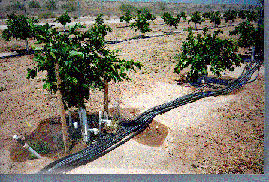Extension and department faculty from the UA College of Agriculture,
including plant scientists, plant pathologists, entomologists and
soil scientists, conduct these trials. The results of their projects
are disseminated to the public through written reports, field days
and seminars. Dean Bacon, director of the CAC, oversees the management
of the experiment station and coordinates the projects that are designed
to match the researchers’ expertise with growers’ needs.
He has sponsored tours of the station for small neighborhood groups
and larger organizations, and gives lectures on growing citrus in
arid climates.
Highlights of Ongoing Projects

Orchard Floor Management: Weeds compete with
trees for water and nutrients, reducing yields. This series of studies
on two two-acre blocks of Mineola tangelos and valencia oranges compares
yields using three different ground cover systems: cover crops (clover),
natural grass and chemically controlled bare ground. The clover serves
both as weed control and as a nitrogen source when it’s disked
into the soil. Results thus far indicate that yields are higher for
trees on bare ground. Temperature checks have shown that there is
no temperature difference between bare ground and covered ground during
the winter, at least in the desert.
Girdling Trees to Increase Yields: Trees that are
cut or girdled around the trunk below the branches tend to flower
and fruit more heavily. The method is labor-intensive and can be too
costly for large orchards, but has its merits in small groves. Researchers
are girdling Fairchild mandarins and has increased their yields; his
next step is to find ways to increase their size as well.
Reducing Granulation in Navel Oranges: When citrus
fruit granulates, it means the normally succulent fruit lacks juice--the
sacs are dry and "ricey." It is thought that calcium binds
the moisture and holds it in a different form. Rootstock, environmental
conditions, watering methods and fertilizing practices all affect
granulation. Only the last two can be controlled once trees are in
the ground. This study includes both regular watering and over-watering
regimes, and nutrient additions, such as boron and potassium.
 Nutrient
Studies: Researchers are checking four different regimes
for adding nitrogen to 18-month-old Newhall navels--weekly, monthly,
three times per year, and the control (none added). The nitrogen is
applied to young trees through the microjet irrigation system. They
have found so far that young citrus doesn’t need to be fertilized:
there is no difference in trunk size or petiole (leaf) sample, in
any of the nitrogen regimes.
Nutrient
Studies: Researchers are checking four different regimes
for adding nitrogen to 18-month-old Newhall navels--weekly, monthly,
three times per year, and the control (none added). The nitrogen is
applied to young trees through the microjet irrigation system. They
have found so far that young citrus doesn’t need to be fertilized:
there is no difference in trunk size or petiole (leaf) sample, in
any of the nitrogen regimes.
Variety Trials: Grapefruit--Because color
really sells grapefruit, this trial is focusing on red and pink-fleshed
grapefruit using Flame, Texas Star and Rio Red varieties. Strawberries:
Will include two varieties plus date of planting. Navel orange:
about 12 varieties on different rootstocks. A deciduous tree variety
trial includes nectarines, apples, peaches, plums, apricots and jujubes.
Organic Citrus: The center has organically grown
tangelos and navel oranges. These blocks of trees were designed to
develop methods and demonstrate to growers that citrus can be grown
organically without a reduction in fruit quality or quantity.
In addition to its research projects, the CAC has taken the
initiative regarding two issues facing both commercial and backyard
growers: transmitting frost warnings and monitoring trees for the
tristeza virus:
Monitoring Systems: An AZMET station at the
Center gathers weather data that feeds into a computer database for
climate conditions in --- locations in Arizona. In addition, Bacon
says that because the national weather service has discontinued its
"first warning" system for frost, the CAC has developed
its own with the help of a private climatologist.
The automated system dials weather stations in 11 different areas
and downloads the data to be read by a meteorologist, who will predict
low temperatures for the following day. The reporting area covers
acres of citrus, from west of Phoenix, 80 miles east to Queen Creek
and south to Picacho. Growers can get the information by calling a
recorder at the Center or receive a faxed version upon request.
The Tristeza Task Force: Bacon helped organize
the Citrus Tristeza Virus-Brown Citrus Aphid Task Force, a group that
surveys all the citrus in the state, both commercial and urban, for
signs of tristeza, a citrus virus also known as quick decline. The
brown citrus aphid (BCA), which is not yet in Arizona, vectors the
disease. "We speculate this vector will arrive in Arizona in
three to five years," Bacon says. In some cases the virus can
kill citrus trees in about three to six weeks; it can also move more
slowly. It affects some rootstocks more than others: for example,
sour orange rootstock is extremely susceptible.
"About fifty percent of the citrus in this area (Maricopa County)
is on sour orange rootstock," Bacon says. If the brown citrus
aphid moves into this area we’re going to be in trouble, not
only in commercial orchards, but also with the three million citrus
trees that are in back yards all over this county."
The task force is collaborating with the Arizona Department of Agriculture
in sampling and monitoring trees across the state for the virus, and
in eliminating infected trees before the aphid can feed on them and
transmit the virus to healthy trees.

"There are about 113 trees that have tested positive so far
in the state," Bacon says. Because emotions can run high regarding
cherished backyard fruit trees, education is very important in persuading
the homeowners to allow the state to remove the infected trees. The
task force has focused on presenting information to community organizations
and to individuals in neighborhoods.